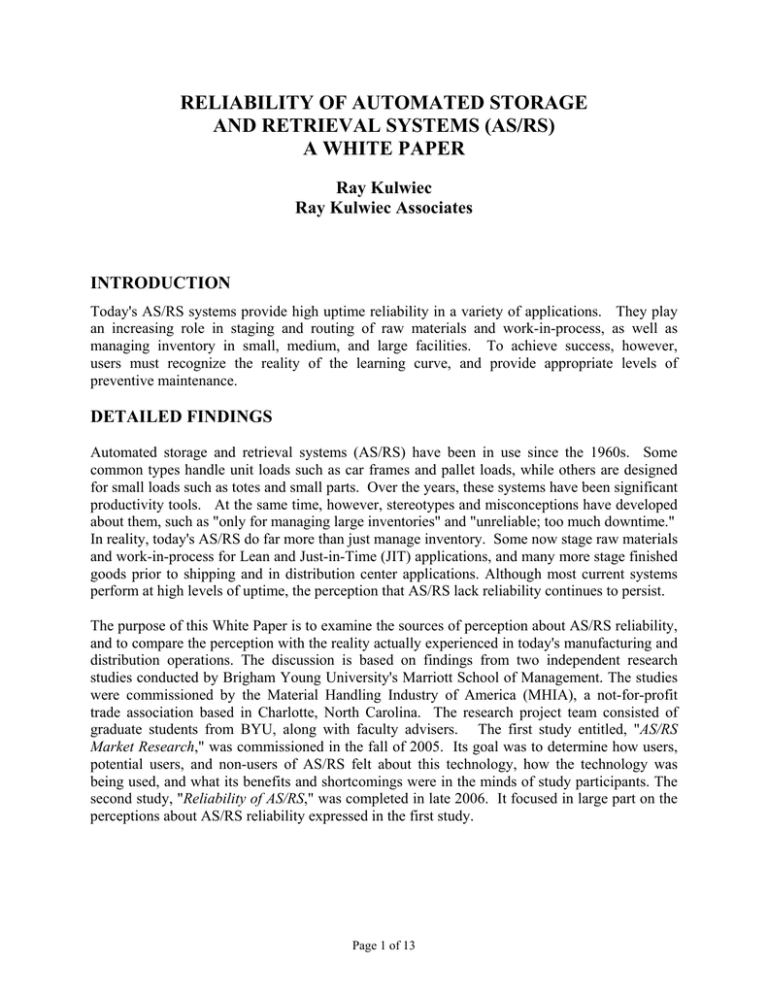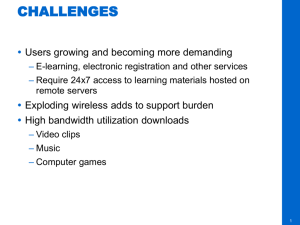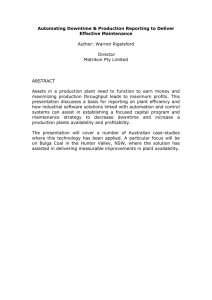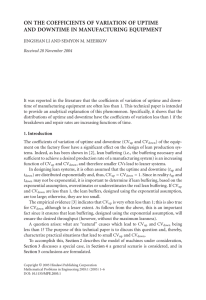RELIABILITY OF AUTOMATED STORAGE AND RETRIEVAL SYSTEMS (AS/RS) A WHITE PAPER Ray Kulwiec
advertisement

RELIABILITY OF AUTOMATED STORAGE AND RETRIEVAL SYSTEMS (AS/RS) A WHITE PAPER Ray Kulwiec Ray Kulwiec Associates INTRODUCTION Today's AS/RS systems provide high uptime reliability in a variety of applications. They play an increasing role in staging and routing of raw materials and work-in-process, as well as managing inventory in small, medium, and large facilities. To achieve success, however, users must recognize the reality of the learning curve, and provide appropriate levels of preventive maintenance. DETAILED FINDINGS Automated storage and retrieval systems (AS/RS) have been in use since the 1960s. Some common types handle unit loads such as car frames and pallet loads, while others are designed for small loads such as totes and small parts. Over the years, these systems have been significant productivity tools. At the same time, however, stereotypes and misconceptions have developed about them, such as "only for managing large inventories" and "unreliable; too much downtime." In reality, today's AS/RS do far more than just manage inventory. Some now stage raw materials and work-in-process for Lean and Just-in-Time (JIT) applications, and many more stage finished goods prior to shipping and in distribution center applications. Although most current systems perform at high levels of uptime, the perception that AS/RS lack reliability continues to persist. The purpose of this White Paper is to examine the sources of perception about AS/RS reliability, and to compare the perception with the reality actually experienced in today's manufacturing and distribution operations. The discussion is based on findings from two independent research studies conducted by Brigham Young University's Marriott School of Management. The studies were commissioned by the Material Handling Industry of America (MHIA), a not-for-profit trade association based in Charlotte, North Carolina. The research project team consisted of graduate students from BYU, along with faculty advisers. The first study entitled, "AS/RS Market Research," was commissioned in the fall of 2005. Its goal was to determine how users, potential users, and non-users of AS/RS felt about this technology, how the technology was being used, and what its benefits and shortcomings were in the minds of study participants. The second study, "Reliability of AS/RS," was completed in late 2006. It focused in large part on the perceptions about AS/RS reliability expressed in the first study. Page 1 of 13 RELIABILITY THE TOP CONCERN The first study was conducted through telephone interviews with three basic groups of participants: 1) Current users of AS/RS; 2) Potential users, and 3) Non-users of AS/RS. The participants were further classified as small, medium, and large corporate organizations. Sources of user contacts were lists from MHIA member companies and Industry Week magazine. Typical job functions included Operations Manager, Project Engineer, and VP Distribution. Among current AS/RS users, downtime (or unreliability) was the greatest worry (approximately 47%) even though some had yet to experience any downtime. Flexibility was in second place (17.6%) followed by sunk cost (i.e., monies already expended), customer service, implementation, and maintenance issues. Even for users having little or no downtime, the potential for downtime was still a major concern. During several interviews, a common theme was echoed: "When one cog goes, the shop is closed." Apparently the perception persisted that AS/RS were somehow vulnerable to downtime and as a result were unreliable. For potential users, downtime came in third, behind maintenance issues (clearly related to reliability) and the perception that AS/RS is only suited for big companies. Other trailing concerns were sunk cost, lost need, flexibility and the lack of "fit" with the facility, "browse ability," and taxes. The research team felt that an additional study was needed to identify the causes of the perception of reliability and to examine the findings in depth to determine whether the perception was correct or not. SECOND STUDY TARGETS RELIABILITY A second study was conducted via e-mail surveys to examine the perceptions about reliability in depth. This time, the survey sample group consisted of users of AS/RS that had been in operation for at least one year. Industries represented included Automotive, Distribution, Food, Logistics, Manufacturing, Military, Printing, Retail, Tobacco, and Academia. The systems studied used computer-controlled storage and retrieval (S/R) machines serving stationary racks or shelving oriented alongside one or more horizontal aisles. These fixed-aisle (F/A) systems utilize load handling devices of varying configurations. The functions of the S/R machines were to: 1) pick up, transport, and insert loads into defined storage locations, and then; 2) at some future point retrieve or extract loads from their storage locations, transport the loads, and deposit them at defined positions for subsequent use outside of the system. Carousels and vertical lift modules, although another form of AS/RS, were not the focus of the research and therefore excluded from the study. FACTORS AFFECTING PERCEPTIONS OF RELIABILITY One of the things the study sought to determine was, "where do perceptions about fixed-aisle AS/RS and their reliability in particular come from?" The following factors beginning with basic sources of information provide some answers. Page 2 of 13 Basic sources of information: The survey questionnaire asked, "Before purchasing your company's AS/RS, where did your perceptions on the reliability of AS/RS originate?" The participant was given the following choices: y y y y y y Industry peers/professional colleagues First-hand experience Magazines, trade journals, literature Trade shows Self-generated, preconceived notion Other (please specify) The findings show that the literature category makes potential users aware of AS/RS. However, comments from industry peers and professional colleagues have the largest influence upon reliability perception. One respondent noted that he became sold on the system when the AS/RS supplier took him on a site visit to a user who had a system with capabilities corresponding to his needs, and he was able to ask engineers specific questions about their operation. Another respondent described his experience in this way: "We had visited a few other companies with AS/RS and still didn't feel comfortable. So, the vendor flew three of us 'on the vendor's nickel' to a site where we could see an AS/RS in an environment similar to ours. I asked one of the engineers how long they had had the system, and he said three years or so. So, I asked, 'What have you had to replace?' He said, 'I don't know, maybe a sensor.' One sensor in three years! That's when we knew that this equipment was pretty reliable." Definition of reliability: In some cases, perceptions about reliability are affected by how one defines the term. In this discussion, reliability refers to uptime. Users who think in terms of system uptime and track uptime measurements tend to have better understanding of and higher perceptions about reliability. One respondent put it this way: "You really made me think. When I started taking the survey I didn't think the system was that reliable, but when I went back and started looking at the efficiencies I really saw how amazing it is, 99.8% efficient. Now I'll change the ways I track the uptime and efficiencies of AS/RS. I really appreciate your questions to get me thinking in this new way." Learning curve: The period immediately following installation and startup requires patience as "kinks" are worked out of equipment and software, and workers become accustomed to the operation of these systems. In many cases, integration is needed not only within the AS/RS, but with other equipment and systems. Perceptions of low reliability may emerge during this trying period, even though new AS/RS typically have fairly high uptime (around 94%) during the first three months. In any event, the learning-curve period must be managed realistically, and the customers themselves must be actively engaged in the process. Users should not expect optimum performance within the first year. However, the survey does show that uptime increases significantly from the first three months to the first year of operation--from 94.05% to 96.22%. Page 3 of 13 Unexpected downtime: Almost two-thirds of the respondents reported that the most frequent performance issue is having the system go down unexpectedly and become inoperable. Obviously it is essential that fast recovery be achieved, and to that end the facility must have quick access to maintenance personnel either internal or external along with immediate availability of needed repair parts. Even if quick recovery is achieved, the emotions related to unexpected downtime can help bring down the perception of reliability, even if overall uptime continues to be high. Identifying chronic problem areas can help get the system up again quickly. For example, almost 40% of respondents indicated that the S/R machine's insertion/extraction mechanism (i.e., the load handling device) posed the greatest problems, with computer control software in second place. Being especially prepared to deal with these issues and including them in a scheduled maintenance program can help avoid downtime or at least speed recovery. Maintenance requirements: One finding from the second study is that current levels of scheduled maintenance did not have a significant impact upon overall uptime. The majority of system downtime was unexpected. The level of required preventative maintenance and repair may raise the question of reliability for some users or potential users. However, the incidence of such unexpected events can be reduced, or even avoided, with appropriate preventive maintenance. What is the appropriate level of maintenance? Respondents' answers varied widely, with the low being as little as one hour/aisle/month. The median was only eight hours/aisle/month (see Figures 1 and 2.) Two users whose AS/RS reliability expectations were greatly exceeded spend 15-20 man-hours/aisle/month on preventive maintenance. Whether a company does its own maintenance or not, suggestions from the system supplier can be helpful in estimating the threshold level of PM that results in acceptable AS/RS uptime. Figure 1. Preventive maintenance is a key to maintaining system uptime. This chart reveals the wide range of PM time spent by study respondents. Page 4 of 13 Figure 2. In-house crews provided maintenance at most respondent facilities. However, whether a company does its own maintenance or not, suggestions from the system supplier can be helpful in estimating the threshold level of PM that result in acceptable AS/RS uptime. Further research on appropriate threshold levels of scheduled maintenance is called for, as well as the type of preventive maintenance being done by those in the higher bracket and when that maintenance is conducted (e.g., off hours), but comments from two different respondents help to put the issue in the proper light: "We do the scheduled maintenance for two reasons: 1) to not void the warranty and 2) because the supplier seems to know what's best for our AS/RS." (This company has its own internal maintenance staff.) "You must maintain the equipment proactively. The more preventive maintenance you expend, the lower your repairs and downtime." Age of system: The survey showed that new systems (less than 1 year) or old ones (greater than 10 years) did not yield the highest levels of uptime. In the first instance, the typical learning curve kept uptime from reaching the optimum level. In the case of systems over 10 years old, increasing levels of maintenance and repair may have begun to affect uptime performance. Two additional observations: First, regardless of age, the load handling device (or inserter/extractor mechanism) continued to require the most maintenance, and after three years of operation, the computer control software was no longer a primary issue. Second, over the longer time period (approaching 10 years) the industry is finding that many customers are upgrading their systems to the latest technologies and therefore those users continue to experience the high levels of performance that they observed in the earlier years. Involvement in purchasing decision: The survey sought to determine what effect involvement in the AS/RS purchase decision had upon the perception of reliability. The following options were posed for answering the question, "How involved were you with the decision to purchase the current AS/RS? y y y y I approved the decision to purchase I helped prepare the proposal to purchase I supplied my input into the decision I was not involved The study showed that those least involved in the decision process tended to have lower reliability expectations than those making the purchase proposal or approving the decision. In Page 5 of 13 general, it is felt that those most familiar with AS/RS are more likely to feel that such systems are quite reliable. CONSEQUENCES OF DOWNTIME Does the dependence of the facility's performance (usually measured as throughput) affect the perception of system reliability? In this study, throughput dependency was defined as the effect one down AS/RS aisle had on the overall throughput of a facility. The survey asked, "If one of your AS/RS aisles is shut down, what percentage of your facility's throughput would be affected?" Figure 3. Most of the systems in the study were designed with redundancy, so if an aisle went down, operations could continue at greater than 50% levels of throughput. The vast majority of respondents (81%) reported that they had less than a 50% throughput dependency on AS/RS. In other words, most of the systems were designed with redundancy, so operations could continue at greater than 50% throughput levels. It was assumed that large systems, with 15 aisles or more, would be affected less by downtime in one aisle. However, most of the medium (7 to 13 aisles) systems also showed throughput dependencies of less than 50%. Even some small systems (1 to 6 aisles) had lower throughput dependencies than had been expected. Those study participants who reported that their AS/RS had slightly missed uptime expectations also reported a low throughput dependency. Those that had the lowest throughput dependency reported that their reliability slightly exceeded their expectations. The bottom line is that no significant correlation could be found between throughput dependency and the user's reliability expectations being met. System improvements: Several users commented that they had made significant improvements to their AS/RS to enhance uptime reliability. One respondent noted the following improvements: y y y y 22 cameras throughout the AS/RS are used to monitor and spot problem areas. Alarm lights are used on gates to identify problems. Numerous software improvements have been implemented. An automatic paging system is used to alert affected users of upcoming delays. Page 6 of 13 This respondent noted that his automatic paging system has calmed AS/RS reliability fears throughout his organization. The problem his manufacturing company faced was that when the AS/RS went down, process stations downstream would not know that their throughput would soon be affected. The automatic paging system sends a status page and/or email to all those affected whenever a fault occurs, or information changes. This allows downstream process managers to adjust to the situation while there is still time to work around the issues. ACTUAL UP-TIME IS HIGH The second-study findings show that experienced AS/RS users have high expectations for their systems, and thus high regard for them. Even before purchasing a system, respondents had an average expected uptime of 97.98%. A total of 87% of the sample expected an uptime of 97.5% or higher. Of this group, about 30.5% expected 99% or higher uptime (always fully operable), while 56.5% expected 97.5% to 99% (downtime seldom being experienced). The remaining 13% expected 90% to 97.5% uptime. (See Figure 4.) Figure 4. Actual uptime measured in the study was high. Most respondents said their system exceeded expectations, an indication that the overwhelming majority were more than pleased with their system's reliability. For the prior full month of operation, the average uptime for the entire group was 97.34%, compared to the expected 97.98%. Of total respondents, 77% said uptime was 97.5% or greater, with 18% experiencing 99% + uptime, and 59% realizing 97.5% + uptime. The great majority of respondents (74%) said their system exceeded expectations. An overwhelming majority are more than pleased with their system reliability. Only 9% of the respondents reported that their system is failing to meet expectations. Of these, half expected the system to be "always fully operable" and the others expected to "seldom have downtime." RELIABILITY OVER TIME The study also looked at actual uptime over time, and examined the impact of scheduled maintenance on uptime. The survey asked, "To the best of your ability, please indicate your company's average AS/RS uptime over: 1) last full month of operation, 2) two months ago, 3) six months ago, and 4) twelve months ago. Participants were asked to use the following definition of uptime: Page 7 of 13 No. of hours per month system is fully operable AS/RS uptime = --------------------------------------------------------------No. of hours system is needed for operation Note: The denominator includes scheduled maintenance repairs if these are usually performed during normal operating hours. The survey then asked the same question, but with the following new definition of uptime: AS/RS uptime = No. of hours per month system is fully operable --------------------------------------------------------------No. of hours system is needed for operation – No. of Hours per month of scheduled maintenance The findings showed slightly less than 20% of respondents experiencing 99+% uptime, about 60% experiencing 97.5% - 99% uptime, and slightly over 20% having 90% - 97.5% uptime. Uptime has stayed relatively consistent over the months. Because the two sets of findings are similar, scheduled maintenance does not appear to have a significant impact on overall uptime. The conclusion: The majority of downtime is unexpected, so being prepared to respond quickly with maintenance is very important. Figure 5. Uptime remained consistently high over a 12-month period. Scheduled maintenance does not appear to have a significant impact on overall uptime, and thus the majority of downtime is unexpected. WHY AS/RS IN THE FIRST PLACE? What goals were the participants' companies seeking to achieve with an AS/RS? The list of operational goals posed by the survey were: y y y y y Accuracy Energy efficiency Increased throughput Inventory control (i.e.--theft prevention/shrinkage) Logistics efficiency Page 8 of 13 y y y y Reduced labor cost Safety Space efficiency Speed/time to access inventory The top operational reason cited for purchasing an AS/RS was space efficiency. Following, in order of importance were increased throughput, reduced labor costs, speed/time to access inventory, and accuracy. The survey revealed no cases in which the AS/RS had greatly missed expectations on any of the goals listed. The majority responded that their AS/RS had met expectations. Space efficiency, which was the number one contributing factor to purchasing the AS/RS, was met or exceeded in all cases, with 43% exceeding expectations and 57% meeting them. The survey also measured return-on-investment (ROI) expectations vs. actual performance. ROI expectations were exceeded for 26% of respondents, and met by 70%. Approximately only 4% of respondents had unmet expectations. The first study provided some added light on perceptions of accuracy and response time. Several respondents commented favorably on "inventory accuracy" and "ability to stage or sequence" inventory. Companies view AS/RS as being efficient at both stacking and retrieving products. They also perceive that because manual inputs are limited, and computers make very few errors, AS/RS are very reliable. ATTITUDES TOWARD AS/RS The accompanying table shows how system age was distributed in the survey sample: Age of system Less than 1 year 1 - 3 years 3 - 5 years 5 - 10 years Over 10 years % of respondents 10% 38% 19% 19% 14% 100% The vast majority of the samples has had significant experience with their AS/RS and has lived through both the "ups and downs" sufficiently to make assessments based on experience. Comments made by respondents on the effectiveness of AS/RS include the following: y y y y y "It is amazing to me what they can accomplish. . .” "It's enabled us to grow at the pace we have.” “Automation is the way to go. The only thing is just keeping up with the technology.” "It’s as reliable as anything out there. I may not be totally satisfied but as far as I am concerned, it's the best way.” "The AS/RS is worth its weight in gold.” Page 9 of 13 y y "Savings--JIT device which saves a company millions of dollars a year in storage, part damage, inventory costs, etc.” "We had an objective. Look at the goals. Consider what would happen if it went down. The AS/RS is customized for each operation. No AS/RS is the same. You have to realize that.” The satisfaction expressed in the above comments extends to recommending AS/RS to others. The survey asked, "Would you ever recommend an AS/RS to another company?" The result: All respondents said they would recommend an AS/RS to another company. Of these, 91.3% said they would "very strongly" recommend it. There were no "nays." Participants were asked what they would say to prospective users about AS/RS reliability. The following are representative comments, with the open-ended comments being summarized in Figure 6: y y y y y y y y "I would say that this is not a valid concern as long as the system is properly maintained, and operators are properly trained.” "The reliability of our AS/RS has never been an issue for us.” "You must maintain the equipment proactively. The more preventive maintenance you expend, the lower your repairs and downtime.” "The system is extremely reliable. Major source of downtime is our own computer systems, not the AS/RS. Actual interruptions of service are usually fixed within minutes or an hour by our own engineers.” "Good points and bad points. When they are down they're down! Make sure you have reliable help and do frequent preventive maintenance. When they are running great they're the greatest.” "It is as good as you let it be. Human or lack of prep usually causes the issues.” "The system we purchased is very reliable. Our first production test run was at 105%.” "We run 24 hours a day and experience less than 5 minutes downtime per week.” Figure 6. Although over a quarter of respondents felt that reliability was not an issue for their AS/RS, over a third stressed the importance of proper preventive maintenance and training to help ensure high uptime. Page 10 of 13 Buyer's remorse: Another question asked in the survey was, "Realizing what you now know about AS/RS (installation, ROI, maintenance, etc.), would you still feel confident purchasing an AS/RS?" Of respondents to this question, 96% felt very sure they would still make the same purchase decision, with more than 50% feeling absolutely confident about the purchase decision. Uncertainty about the purchasing decision was expressed by only 4%. Figure 7. The vast majority of users are very satisfied with their decision to acquire an AS/RS and would make the same decision again. DEALING WITH OTHER MISCONCEPTIONS Findings from the first study show that in addition to reliability, several other misconceptions exist, which are examined in the following discussion. "AS/RS are useful only for managing large amounts of inventory." By now, the satisfaction of AS/RS users covered in the second study has been well documented. The systems involved range in size from 1 to 25 aisles, with an average size being 7.4 aisles. The great majority (57%) had only 1 to 5 aisles. The findings show that AS/RS have not only proven useful, but in many cases have exceeded performance expectations for users of small to large systems. At least one AS/RS supplier noted in the first study that many of its offshore installations were smaller systems. Small systems used to facilitate material movement can be especially suited for use in Lean/JIT applications, as discussed below. "AS/RS can only be economical in large installations." The results of the second study show that 26.1% of respondents reported their ROI expectations were exceeded. Another 69.6% said their system met expectations. Thus, almost 96% of the respondents-- users of small, medium, and large systems alike--said their AS/RS either met or exceeded ROI expectations. Size alone does not appear to have a bearing on the economic viability of a system. Page 11 of 13 Economies also surface for many companies that store or move large amounts of products in harsh work environments such as refrigerated warehouses, high-noise environments, or hazardous conditions. Savings on electricity and hazard pay alone can provide significant benefits. Example: One company operating a refrigerated warehouse reduced their annual electric bill by over $70,000 after installing an AS/RS. "Efficient use of space is not as big a deal in the U.S. as in Europe or Japan." It is true that land costs are much higher in Europe and Japan, and in general more space is available to U.S.-based companies. However, 40% of respondents to the second survey said that space efficiency was the single most important factor influencing their buying decision. In the first study, over 50% cited space conservation as an important benefit. Many companies have applied AS/RS as an addition or remodeling to their existing facility, and space is an issue. Without moving an entire operation, these users need to find a way to make the existing facility footprint work for their needs. Space considerations were more pronounced on the East Coast and among metropolitan areas, due to more limited land availability than in the West or in more rural locations. "AS/RS cannot fit in Lean or JIT environments." Some potential users envision AS/RS as being principally an inventory management system, especially for large operations. Yet some companies have been able to use AS/RS in other, innovative ways. Comments from a respondent with a metal fabricator help make the point: "We have a crane-in-aisle system in place. We are a metal fabricator that was looking to go from our old system to a highly automated new system that would include AS/RS. The AS/RS component would allow for the efficient storage and retrieval of work-in-process and raw material.” “We decided to build a new facility to accommodate the AS/RS and other automation, and had the AS/RS coordinated with the construction of the new facility. The system came together nicely and has been in use for 18 months, with a capacity of 270 cassettes, similar to SKUs. These cassettes hold and deliver raw materials and WIP, with an emphasis on quick delivery to workstations rather than storage." In this and related examples the first "S" in AS/RS could better stand for "staging" instead of "storage", and the "R" for "routing" (to workstations) instead of merely "retrieval." Conclusion There are definite opportunities for expanding the role of AS/RS in today's Lean and JIToriented applications, as well as in modern distribution centers where rapid order fulfillment plays such a large role. Ideally, space efficiency, time efficiency, accuracy, and other benefits inherent in AS/RS, combined with the flexibility needed for coping with today's world of rapid change, make for a powerful tool in many applications, especially those applications where superior customer service is such an important factor. In some cases, the answer may be working with vendors to produce systems customized to meet specific needs, but having the flexibility needed to cope with change. Page 12 of 13 The key to AS/RS living up to their potential as a tool for productivity improvement across the supply chain is the confidence users hold for the reliability of these types of systems, allowing them to be applied more broadly than in the past. Current research studies clearly show that today's AS/RS do offer these very high levels of reliability. Page 13 of 13






